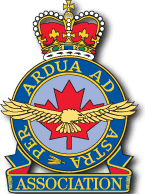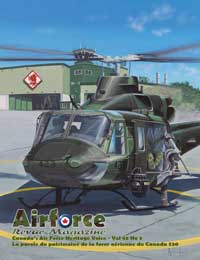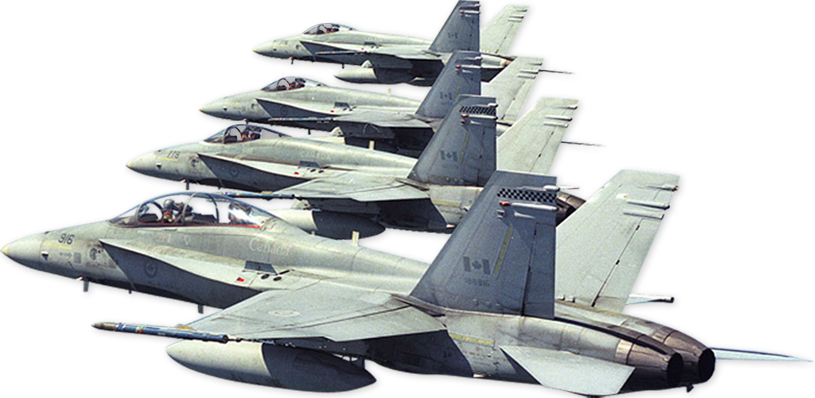 No. 400 Squadron
No. 400 Squadron
Badge: In front of two tomahawks in saltire an eagle’s head erased
Motto: Percussuri vigiles (On the watch to strike).
Authority: King George VI, September 1942.
The eagle’s head indicates the squadron’s role as a reconnaissance unit on army co-operation work; the tomahawks indicate the type of aircraft with which it was once equipped.
Formed in Canada as No. 110 “City of Toronto” (Army Co-operation) Squadron (Auxiliary) on 5 October 1932, the squadron arrived in England with Lysander aircraft in February 1940, was renumbered No. 400 (Army Co-opera- tion) Squadron at Odiham, Hampshire on 1 March 1941 and redesignated Fighter Reconnaissance on 28 June 1943. The unit flew Mustang and Spitfire aircraft on photographic reconnaissance work, collecting photographic intelligence for Allied invasion planners, and before-and-after photographs of Allied air attacks against German “Noball” (V-1 flying bomb) launching sites, following the Allied invasion of Europe in June 1944, it provided tactical photographic reconnaissance for the British Second Army in Northwest Europe. The squadron was disbanded at Luneburg, Germany on 7 August 1945.
Brief Chronology Formed as No. 110 “City of Toronto” (AC) Sqn (Aux), Toronto, Ont. 5 Oct 32. Renumbered No. 400 (AC) Sqn, Odiham, Hants., Eng. 1 Mar 41. Redesignated No. 400 (FR) Sqn, Dunsfold, Surrey 28 Jun 43. Disbanded at Luneburg, Ger. 7 Aug 45.
Title: “City of Toronto”
Adoption: City Council of Toronto, Ont.
Commanders (to learn more about those with gallantry awards please visit our “Search Awards” page and search using their last name)
- W/C R.M. McKay 1 Mar 41 – 11 Aug 41
- W/C H.W. Kerby 12 Aug 41 – 9 May 42 repat.
- S/L Robert Charles Arthur “Bunt” Waddell, DSO, DFC, 10 May 42 – 14 Jul 4.3
- S/L W.B. Woods, DFC 15 Jul 43 – ll Sep 43 repat.
- W/C R.A. Ellis, DFC 12 Sep 43 – 13 Nov 44 repat.
- S/L M.G. Brown, DFC and Bar 14 Nov 44 – 1 Jul 45 repat.
- S/L J.A. Morton, DFC 2 Jul 45 – 7 Aug 45.
Higher Formations and Squadron Locations
Army Co-operation Command:
No. 35 (Army Co-operation) Wing (RAF),
No. 39 (Arrny Co-operation) Wing (RCAF) (12 Sep 42)
- Odiham, Hants. 1 Mar 41 – 3 Dec 42.
Fighter Command: No. 10 Group,
- “A” Flight, Middle Wallop, Hants. (training and operations in fighter tactics) 27 Oct – 28 Dec 42.
- Dunsfold, Surrey 4 Dec 42 – 27 Dec 42. (1)
Coastal Command: No. 19 Group,
6 aircraft (fighter escort over the Bay of Biscay)
- Portreath, Cornwall 3-23 Dec 42.
- Trebelzue, Cornwall 24 Dec 42 – 14 Jan 43.
Fighter Command: No. 10 Group,
- Middle Wallop, Hants. 28 Dec 42 – 13 Jan 43.
Army Co-operation Command:
No. 39 (Army Co-operation) Wing (RCAF),
- Dunsfold, Surrey 14 Jan 43 – 27 Jul 43
Second Tactical Air Force:
No 83 Composite Group,
No 39 (RCAF) Sector (disbanded 1 Jul 44),
No 128 (RCAF) Wing (disbanded 1 Jul 44),
- Woodchurch, Kent 28 Jul 43 – 14 Oct 43
- Redhill, Surrey 15 Oct 43 – 17 Feb 44
- Kenley, Surry (Redhill runways under repair) 2-30 Dec 43.
- Odiham Hants. 18 Feb 44 – 30 Jun 44.
No 39 (RCAF) Wing
- B(Base) 8 Sommerview, Fr. 1 Jul 44 – 14 Aug 44
- “B” Flight remained at Odiham until 10 Aug 44.
- B.21 Ste-Honorine-de-Ducy, Fr. 15 Aug 44 – 31 Aug 44
- B.34 Avrilly, Fr. 1 Sep 44 – 19 Sep 44
- B.66 Blakenburg, Bel. 20 Sep 44 – 2 Oct 44.
- B.78 Eindhoven, Neth. 3 Oct 44 – 6 Mar 45.
- B.90 Petit-Brogel, Bel. 7 Mar 45 – 9 Apr 45.
- B.108 Rheine, Ger. 10 Apr 45 – 15 Apr 45
- B.116 Wunstorf, Ger. 16 Apr 45 – 27 Apr 45.
- B.154 Soltau, Ger. 28 Apr 45 – 6 May 45.
- B.156 Luneburg, Ger. 7 May 45 – 17 Jul 45.
- B.160 Copenhagen, Den. 18 Jul 45 – 1 Aug 45.
- B.156 Luneburg, Ger. 2 Aug 45 – 7 Aug 45.
Representative Aircraft (Unit Code SP)
Westland Lysander Mk.III (Mar – Apr 41)
- R9001 R9009 R9119 R9125
Curtiss Tomahawk Mk.I, IIA & IIB (Apr 41 – Jul 42)
- AH789 L AH806 W AH824 F AH831 N AH841 K AH862 J AN895 B AK324 S AK481 Y AK528 B
North American Mustang Mk.I (Jun 42 – Feb 44) (2)
- AG488 B AG521 P AG528 B AG583 G AG587 L AG591 A AG615 Q AG641 V AG658 T AG659 U AG661 X AL971 S AM126 D AM129 M AM184 N AM187 J AM237 E AM256 Y AP191 O
de Havilland Mosquito P.R. Mk.XVI (Dec 43 – May 44, 6 aircraft) (3)
- MM273 MM284 MM306 MM353
Supermarine Spitfire P.R.Mk.XI (Dec 43 – Aug 45)
- PL799 PM124 PM133 PM158
Operational History: First Mission 6 November 1941, 2 Tomahawks from Odiham – reconnaissance Le Treport to Courtrai; not completed, insufficient cloud cover.
First Victory Aircraft: 7 November 1942, F/O F.E. Hanton in Mustang AG660 SP-W from Middle Wallop – returning from a rhubarb near Caen, was attacked five miles from the French coast and credited with a bf.109 probably destroyed. Ground: 27 November 1942, F/O D.M. Grant in Mustang AP259 SP-R from Dunsfold – night ranger to Paris, joined the circuit of an enemy night flying school 15 miles south of Paris and credited with a Do.217 destroyed.
Last Mission: 8 May 1945, 2 Spitfires from Luneburg – sea patrols.
Summary Sorties: 3,000.
- Operational/Non-operational Flying Hours: 4833/13,907.
- Victories:
- Aircraft: 9 destroyed, 2 probably destroyed, 9 damaged.
- Ground: 15 locomotives destroyed, 1 probably destroyed, 75 damaged; 34 trains, 23 miscellaneous targets damaged.
- Casualties:
- Operational: 12 pilots killed or missing, 2 wounded.
- Non-operational: 17 killed, 2 died.
Top scores: F/L F.E.W. Hanton, DFC 2-0-0 aircraft, 35 locomotives. F/L D.M. Grant, DFC 2-0-0 aircraft, 9 locomotives.
Honours and Awards: 1 Bar to DFC, 10 DFCs, 1 BEM, 3 MiDs.
Battle Honours:
- Fortress Europe 1941-1944; Dieppe.
- France and Germany 1944-45: Normandy 1944, Arnhem, Rhine.
- Biscay 1942-1943.
(1) The flight was employed on “rhubarb” operations (attacks on ground targets of opportunity, in pairs) and acquired a reputation for destroying railway locomotives.
(2) While flying under Fighter Command, Mustang aircraft carried a full set of code letters, alter reduced to the single aircraft letter under Second Tactical Air Force.
(3) 43 Mosquito high-level photographic sorties were flown between 26 march and 2 may 1944.





 No.
No. 


